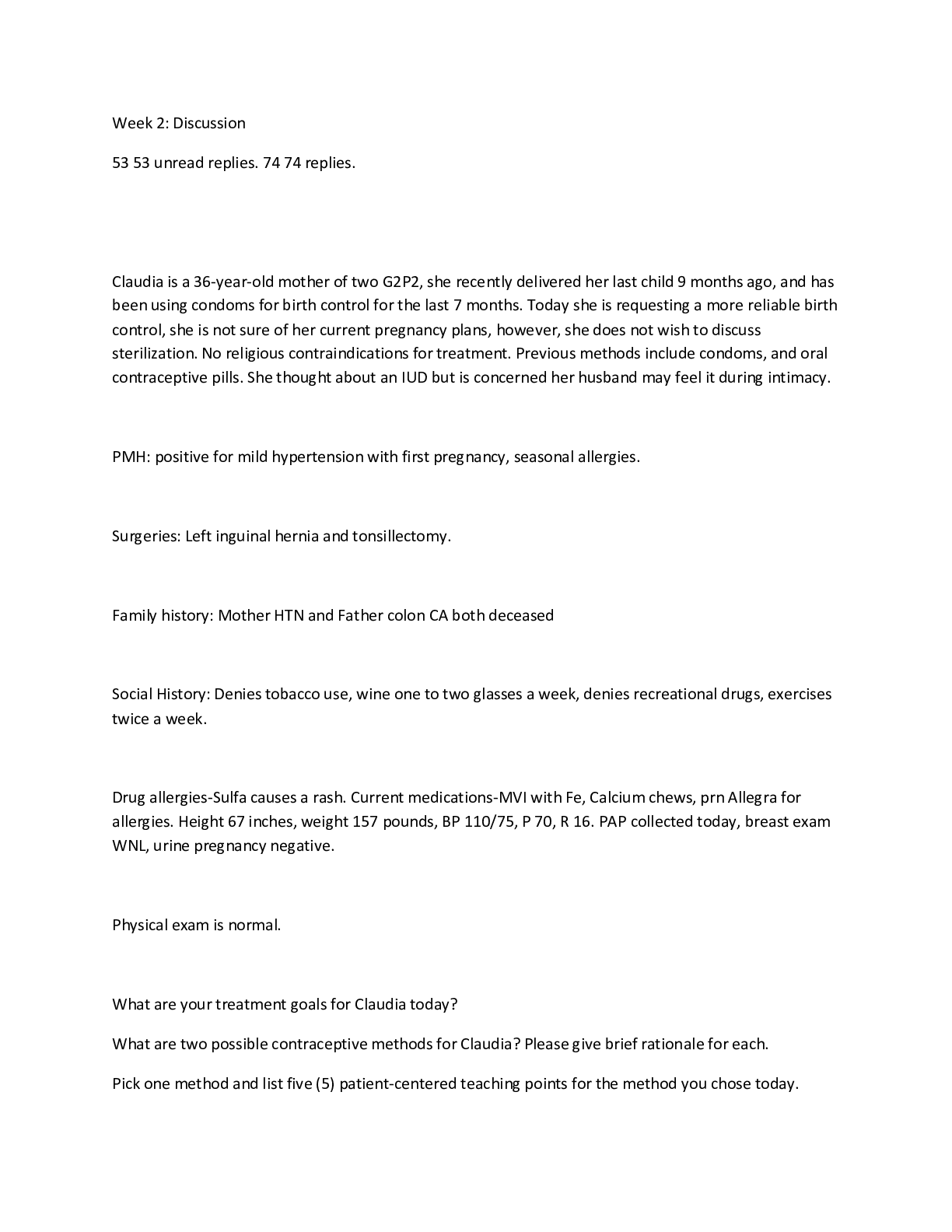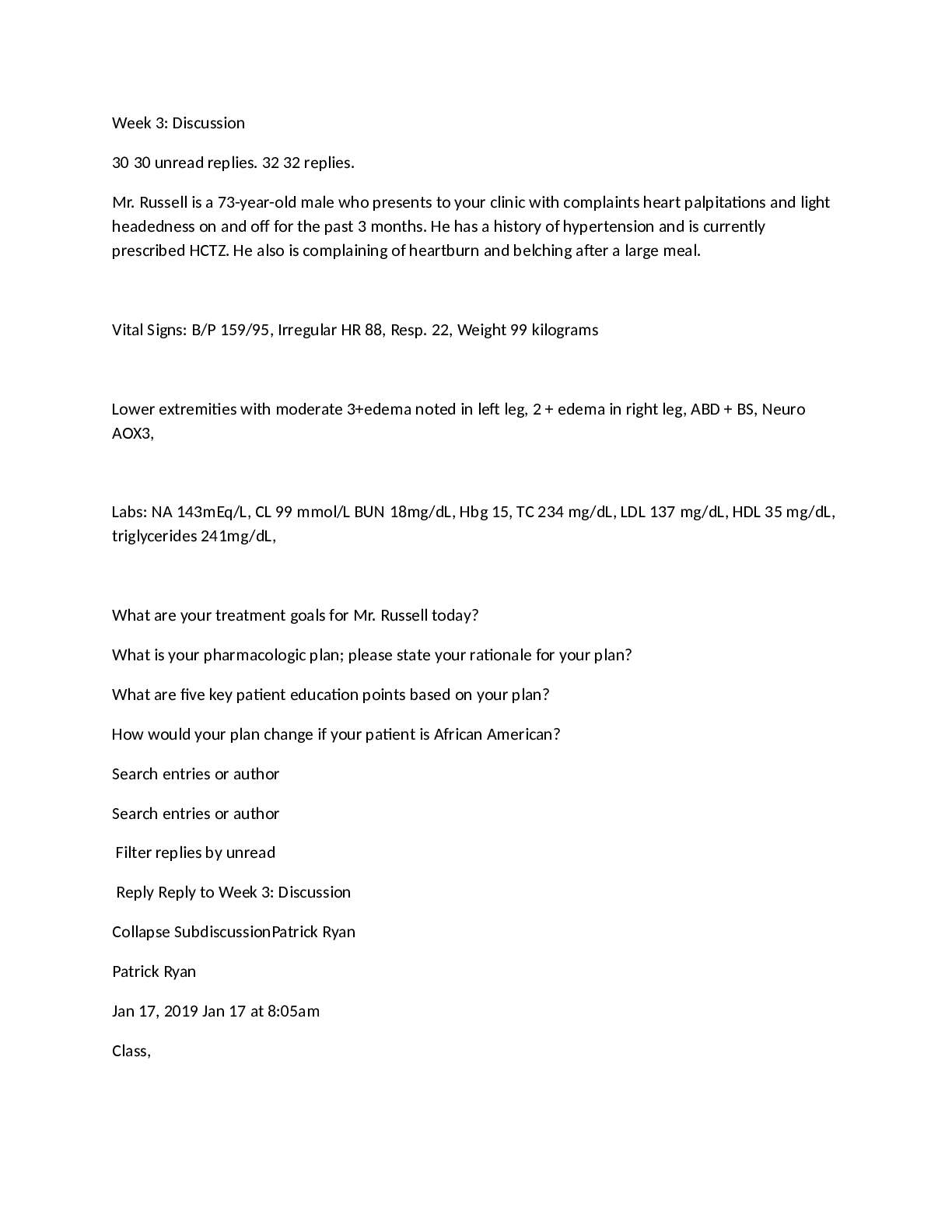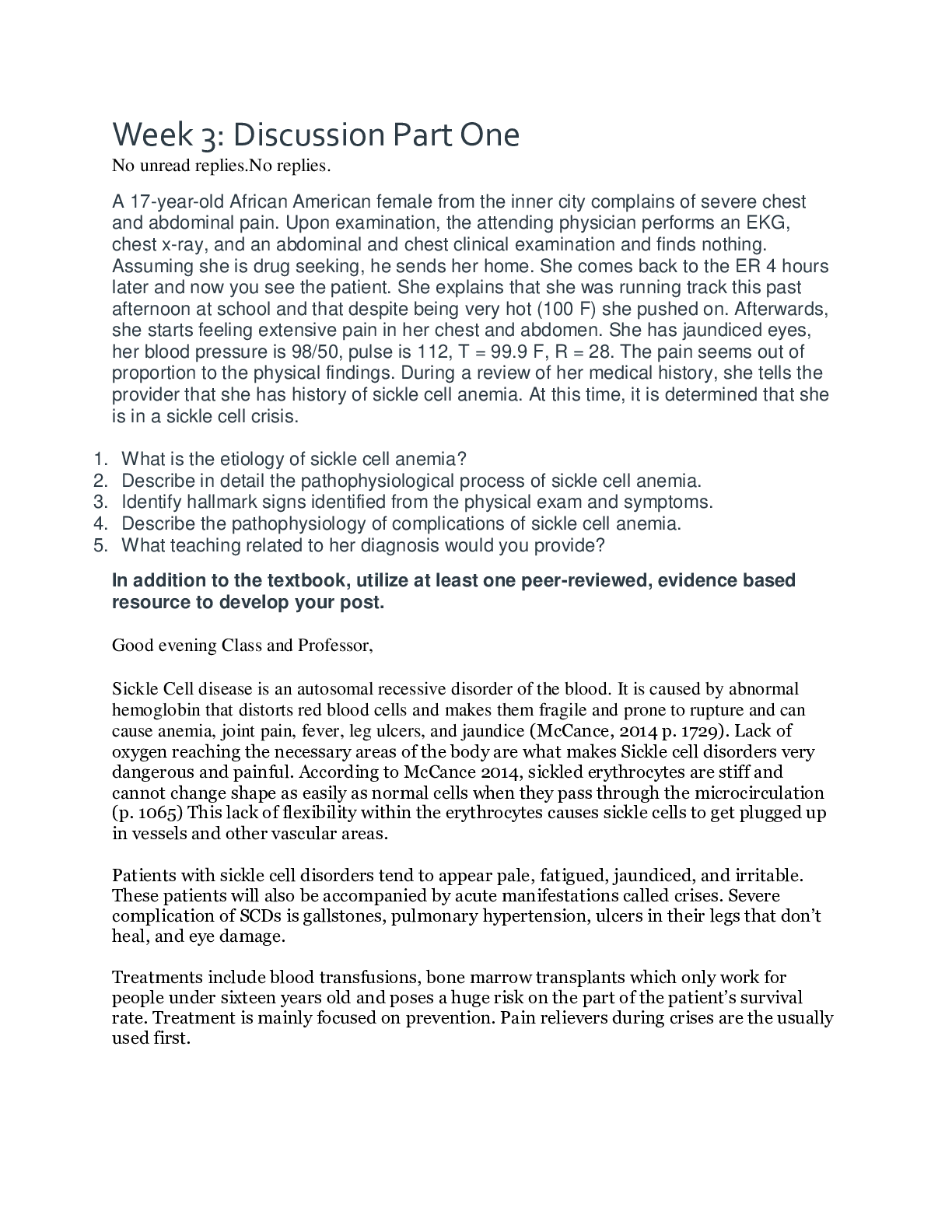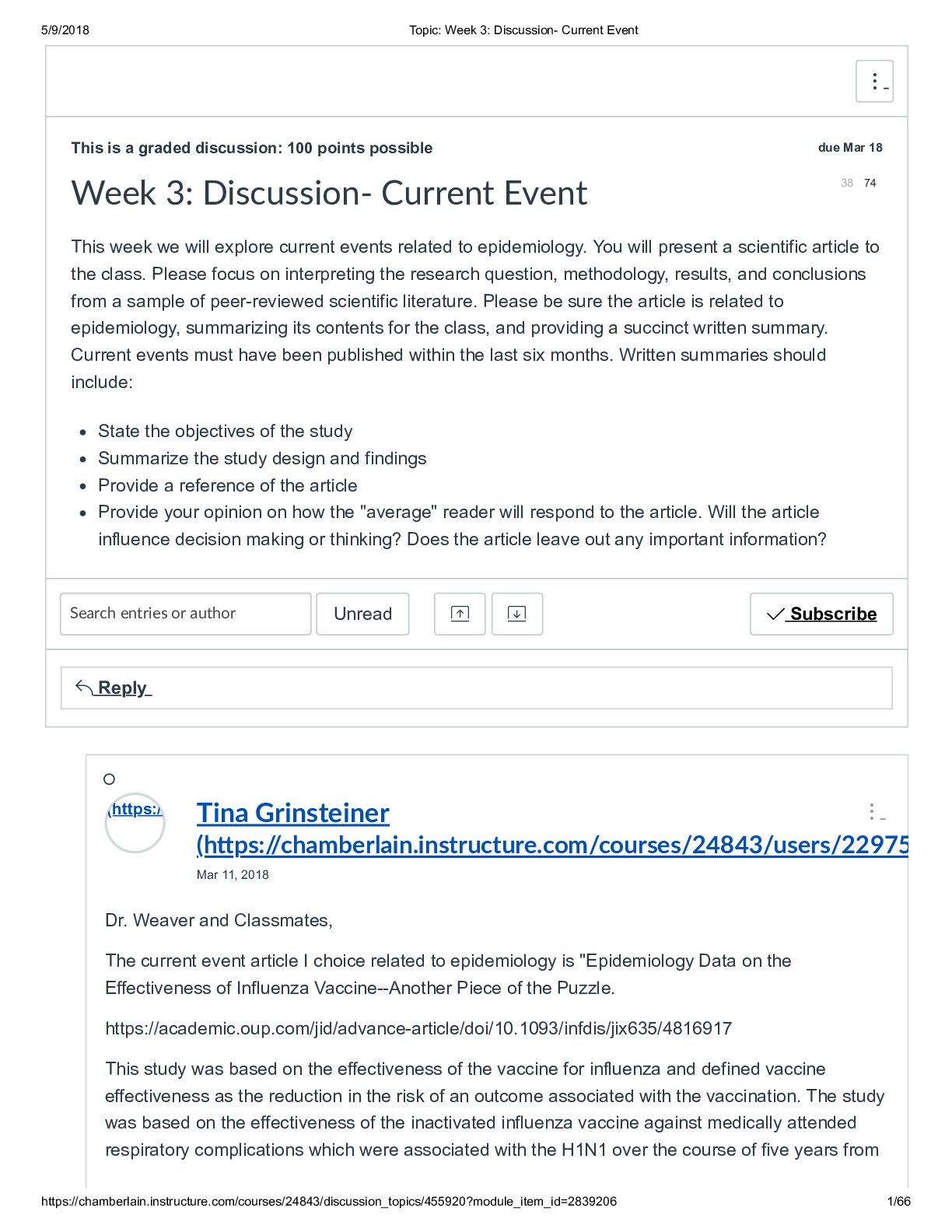*NURSING > DISCUSSION POST > NURSING NR 451 Week 1 and Week 2 Discussions Latest 2020 (All)
NURSING NR 451 Week 1 and Week 2 Discussions Latest 2020
Document Content and Description Below
Week 2 Forming the PICO Question (graded) Form a PICO question that you will use for your change project. Include each element of the PICO question. How did you develop this question? Why is it imp... ortant to your clinical practice? Respond This section lists options that can be used to view responses. Collapse All Print View Show Options Responses Responses are listed below in the following order: response, author and the date and time the response is posted. Sort by Read/Unread Sort by Response Sorted Ascending, click to sort descending Sort by Author Sort by Date/Time* (an instructor response) Collapse Mark as Read Introductory Post Instructor Card Email this Author 4/22/2015 11:11:53 AM Please share a PICO question related to nursing in your specific job setting that you plan to use for your course project in this class. Discuss the following: How did you come up with this question? What internal and external data can be identified that are relevant to this problem? Again, please remember, this should be a PICO question/statement that goes with the problem you will be addressing in your Change Project for this course, so be sure to read the Course Project Guidelines under the Course Project Files in Doc Sharing for more information regarding the assignments for it when identifying your question. Respond Collapse Mark as Read RE: Introductory Post Lisa Hunt Email this Author 5/13/2015 8:42:10 PM Hello all I work on a medicine/stroke unit and this population is at high risk for falls. Many of the cva patients suffer right side brain injury affects their understanding. Many of the patients may state they understand to call before getting up and will forget to call for help when they need to go to the bathroom. Many of the falls on the unit are due to the patient trying to get up and go to the bathroom. On my unit we have had 27 falls and are working diligently to decrease this number through re educating the staff on fall preventive equipment, assessing patient for high risk factors and doing purposeful hourly rounding. My hospital instituted purposeful hourly rounding in the orientation process and should include toileting the patient, and checking the patient to ensure safety measures are in place and to reduce falls with injury. The question raised is, are all staff members really doing purposeful hourly rounding to ensure patient safety and satisfaction. Hourly rounding is an EBP and has shown to increase patient satisfaction. My question is does purposeful hourly rounding help decrease falls if done purposefuly P: population/stroke patients I: purposeful hourly rounding C: not doing purposeful hourly rounding O: prevent/decrease the number of falls Reference: http://www.strokesmart.org/article?id=251 http://www.ncbi.nlm.nih.gov/pubmed/20803880 Lisa Respond (an instructor response) Collapse Mark as Read RE: Introductory Post Instructor Card Email this Author 5/16/2015 1:20:23 PM This is a very good question to address for stroke patient safety Lisa - you have put it into PICO format well. Respond Collapse Mark as Read RE: Introductory Post Saynetta George Email this Author 5/13/2015 10:49:41 PM Hello Professor Card and class, I am in a recent change of dynamics to a telephonic case manager for a managed care organization from a float nurse at a hospital. I have realized the bedside is becoming more and more difficult for me. My PICO includes the rationale I have for leaving the bedside which is working the unit with less nurses, or in nurse slang "working short" Internal data includes the hospital increasing our pay and providing bonuses to the nurses who stay in spite of the shortage and burnout they experience. The external data can be that nurses are leaving the bedside due to impossible demands and early burnout related to constantly being asked to work short and when errors occur we are suspended or written up. Patient safety and satisfaction surveys are low because client's feel as if they are being ignored. P= Problem Not enough nursing staff to accommodate the client load I= Intervention Add more nursing staff to add coverage that increases client safety C= Comparison As we look at other hospitals in other cities what is their nurse-client ratio and how can we implement the manner in which we can have safer client ratios O= Outcome How are our client's improved by overworked nurses and is burnout a possibility and how can hospitals prevent understaffing T- How long should nurses be made to work in these dangerous conditions before law makers implement changes and create new laws to prevent this from occurring. Will client's be seriously hurt or even die because of a nursing staff shortage? Renee American Nurses Association. (2010). Nursing: Scope and standards of practice (2nd ed.). Silver Spring. MD: Author Dearholt, S. L., & Dang, D. (2012). Johns Hopkins nursing-evidence-based practice: Model and guidelines (2nd ed.). Indianapolis, IN: Sigma Theta Tau International Respond (an instructor response) Collapse Mark as Read RE: Introductory Post Instructor Card Email this Author 5/16/2015 1:25:33 PM Good discussion of this question Saynetta - in addition to looking at how other hospitals staff, you should be comparing how increased staffing (your intervention) with the current practice of staffing now to see if there would be improved patient outcome. Respond Collapse Mark as Read RE: Introductory Post Saynetta George Email this Author 5/16/2015 10:31:19 PM Hi Professor Card, Thank you for your suggestion. I will include these interventions also. The results will be amazing to view. I am excited to complete the research to this. Renee Respond Collapse Mark as Read RE: Introductory Post Jessica Quinn Email this Author 5/16/2015 5:28:31 PM Saynetta, excellent topic! Adequate staffing leads to improved patient outcomes and care. I am working as a float Nurse for all of the Med-Surg/Tele Areas and it is tough when we are working short! Our unit supervisors staff the units based on patient census rather than patient acuity which is unfair and unsafe. A nurse might have 6 patients with 5 complete cares or 4 unstable patients. In order to provide optimal patient care and patient education, we must have help and a reasonable nurse to patient ratio. Also, there has been increased incidences of falls throughout the hospital, two with injury, and some patients who are high fall risk require 1:1 observation which pulls one of our CNAs off the floor. I am sure there is a ton of research proving better staffing = better patient outcomes and overall satisfaction. Respond Collapse Mark as Read RE: Introductory Post Shellie Cartwright Email this Author 5/17/2015 12:14:28 AM Instructor Card and classmates, I currently work for an organization that has had a large increase in census within the ER and overall admissions to the hospital as a whole. The hospital I work for is Magnet certified and is constantly evaluating ways in which to provide high-quality, evidence-based, patient-centered care with an effective and efficient process. An efficient process considers the flow of throughput, or flow of patients from beginning to end of their hospital stay, be it outpatient or inpatient. Aligning with Magnet, the organization collaborates with nursing through the shared-governance committees. The committees continually listen to new ideas backed with evidence and research to bring positive change to the patients and/or staff. "Organizations are in a unique position to become pioneers of the future and to demonstrate solutions to numerous problems inherent in today's healthcare systems. Beyond the "What" and "How", organizations must ask themselves what difference these efforts have made" (ANA, pg. 6). Working in the ER it is always a race against the clock, while providing high-quality, safe care to patients. Patients present to the ER and want to be evaluated, treated and have a disposition quickly. Each patient has a different perception or expectation of how much time this process should take. Often it is necessary to explain to patients they are not taken back in order of arrival, but rather in order of priority. There are different reasons that delay patients through the ER process. One area of contention noted is that of lengthy turn around times for simple diagnostic procedures, such as, urine dip test, rapid strep tests, cardiac markers, and urine pregnancy tests. Above all, I can say that at my facility the delay in treatment, and testing is significantly delayed awaiting urine pregnancy tests. Woman wait for certain medications, such as pain medications, and specific diagnostic tests, such as CT scans, awaiting urine pregnancy results. If the ER had point of care testing, the urine pregnancy results could be obtained much more quickly, versus waiting for the lab to result the data. This issue has been identified by the staff and ER physicians as a cause of delay for patients. According to Dearholt and Dang, "problem-focused triggers are those identified by staff during routine monitoring of quality, risk, adverse event, financial, or benchmarking data" (2012, pg. 59). Forming a PICO format to address the issue of point of care testing, specifically urine pregnancy tests, is critical to clearly identifying the problem which evidence-based research will be framed. [Show More]
Last updated: 2 years ago
Preview 1 out of 184 pages
.png)
Buy this document to get the full access instantly
Instant Download Access after purchase
Buy NowInstant download
We Accept:

Reviews( 0 )
$20.00
Can't find what you want? Try our AI powered Search
Document information
Connected school, study & course
About the document
Uploaded On
Oct 27, 2020
Number of pages
184
Written in
Additional information
This document has been written for:
Uploaded
Oct 27, 2020
Downloads
0
Views
105



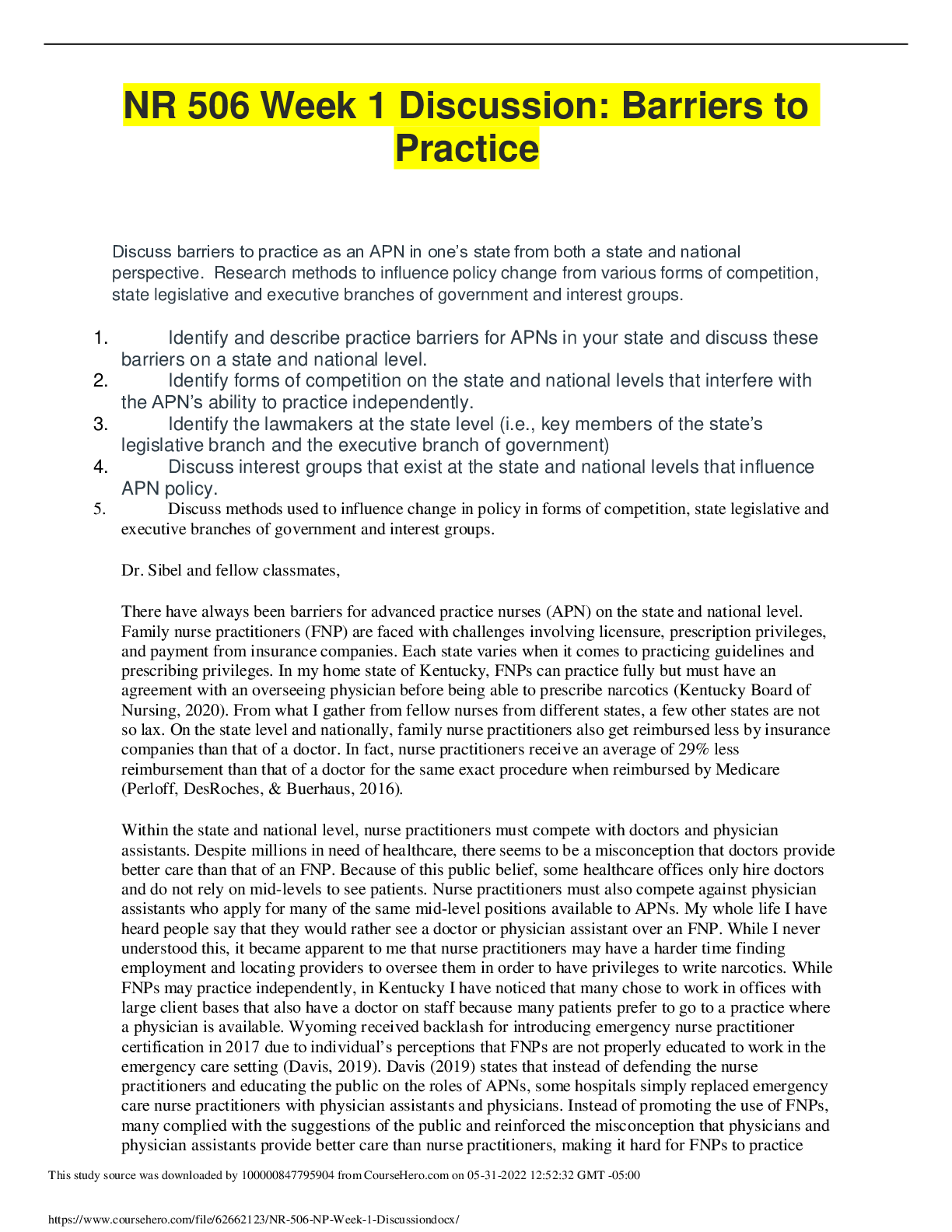
.png)


